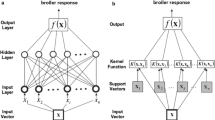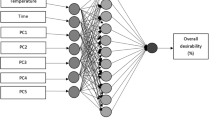Abstract
In order to evaluate rapid testing methods based on the relationship between feed abrasive value (FAV) and physicochemical properties (particle size, bulk density, dry matter (DM), soluble dry matter, water-holding capacity (WHC), ash, crud protein, neutral detergent fiber (NDF), physically effective NDF and non-fibrous carbohydrates (NFC)), 100 empirical dataset were used. Relationships were investigated using multiple linear regression (MLR) and artificial neural networks (ANNs). The mean relative error was significantly (P < 0.01) lower for ANN than MLR model. Globally, the non-linear ANN model approach is shown to provide a better prediction of FAV than linear multiple regression.


Similar content being viewed by others
References
McGavin MD, Morrill JL (1976) Scanning electron microscopy of ruminal papillae in calves fed various amounts and forms of roughage. Am J Vet Res 37:497
Gilliland RL, Bush LJ, Friend JD (1962) Relation of ration composition to rumen development in early-weaned dairy calves with observations on ruminal parakeratosis. J Dairy Sci 45:1211–1217
Rickard MD, Ternouth JH (1965) The effect of the increased dietary volatile fatty acids on the morphological and physiological development of lambs with particular reference to the rumen. J Agric Sci 65:371–382
Beharka AA, Nagaraja TG, Morrill JL, Kennedy GA, Klemm RD (1998) Effect of form of diet on anatomical, microbial, and fermentative development of the rumen of neonatal calves. J Dairy Sci 81:1946–1955
Anderson MJ, Khoyloo M, Walters JL (1982) Effect of feeding whole cottonseed on intake, body weight, and reticulorumen development of young Holstein calves. J Dairy Sci 65:764–772
Zitnan R, Voigt J, Schomhusen U, Wegner J, Kokardova M, Hagemeister H, Levkut M, Kuhla S, Sommer A (1998) Influence of dietary concentrate to forage ratio on the development of rumen mucosa in calves. Arch Tierernahr 51:279–291
Greenwood RH, Morrill JL, Titgemeyer EC (1997) Using dry feed intake as a percentage of initial body weight as a weaning criterion. J Dairy Sci 80:2542–2546
Heinrichs J (2005) Rumen development in the dairy calf. Adv Dairy Technol 17:179–187
Greenwood RH, Morrill JL, Titgemeyer EC, Kennedy GA (1997) A new method of measuring diet abrasion and its effect on the development of the forestomach. J Dairy Sci 80:2534–2541
Dayhoff JE (1990) Neural network architectures. Van Nostrand Reinhold, New York
Marengo E, Bobba M, Robotti E, Liparota MC (2006) Modeling of the polluting emissions from a cement production plant by partial least squares, principal component regression, and artificial neural networks. Environ Sci Technol 40:272–280
Alp M, Cigizoglu HK (2007) Suspended sediment load simulation by two artificial neural network methods using hydrometeorological data. Environ Model Softw 22:2–13
Giger-Reverdin S (2000) Characterization of feedstuffs for ruminants using some physical parameters. Anim Feed Sci Technol 86:53–69
Association of Official Analytical Chemists (AOAC) (2002) Official methods of analysis, vol 1, 17th edn. AOAC, Arlington, VA
Van Soest PJ, Robertson JB, Lewis BA (1991) Methods for dietary fiber, neutral detergent fiber, and non-starch polysaccharide in relation to animal nutrition. J Dairy Sci 74:3583–3597
National Research Council (NRC) (2001) Nutrient requirements of dairy cattle, 7th rev edn. Natl Acad Sci, Washington, DC
Kononoff PJ (2002) The effect of ration particle size on dairy cows in early lactation. Ph.D. Thesis. The Pennsylvania State University
Mertens DR (1997) Creating a system for meeting the fiber requirements of dairy cows. J Dairy Sci 80:1463–1481
Cybenko GC (1989) Approximations by super positions of a sigmoidal function. Math Control Signals Syst 2(3):303–314
Berry MJA, Linoff G (1997) Data mining techniques. Wiley, New York
Kaps M, Lamberson WR (2004) Biosatistical for animal science. Cabi Publishing, New Jersey
Author information
Authors and Affiliations
Corresponding author
Rights and permissions
About this article
Cite this article
Norouzian, M.A., Asadpour, S. Prediction of feed abrasive value by artificial neural networks and multiple linear regression. Neural Comput & Applic 21, 905–909 (2012). https://doi.org/10.1007/s00521-011-0579-5
Received:
Accepted:
Published:
Issue Date:
DOI: https://doi.org/10.1007/s00521-011-0579-5




